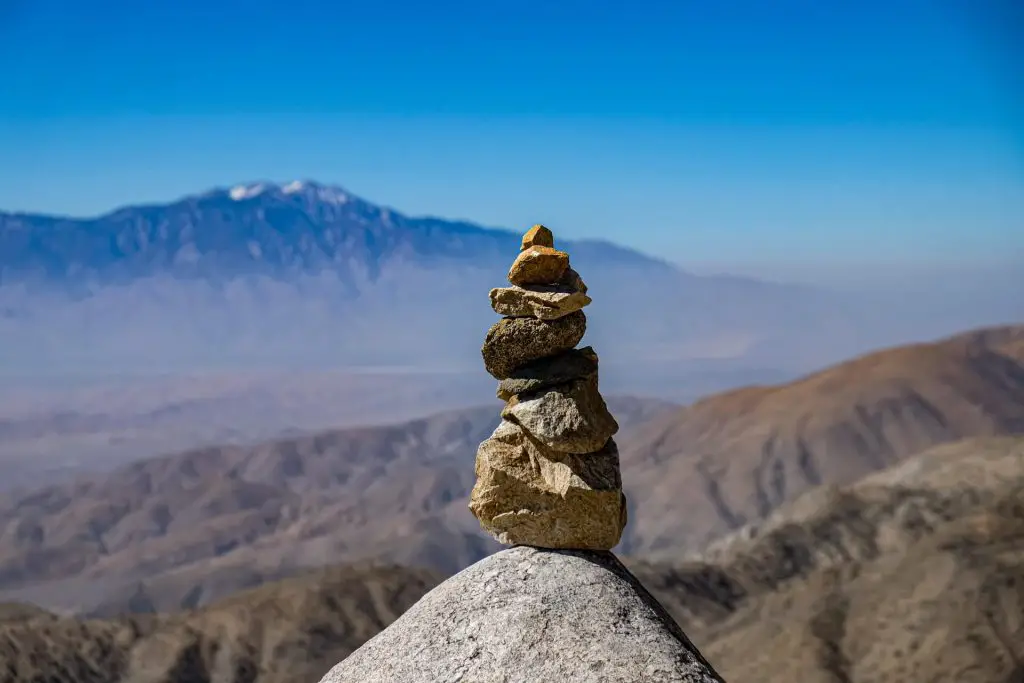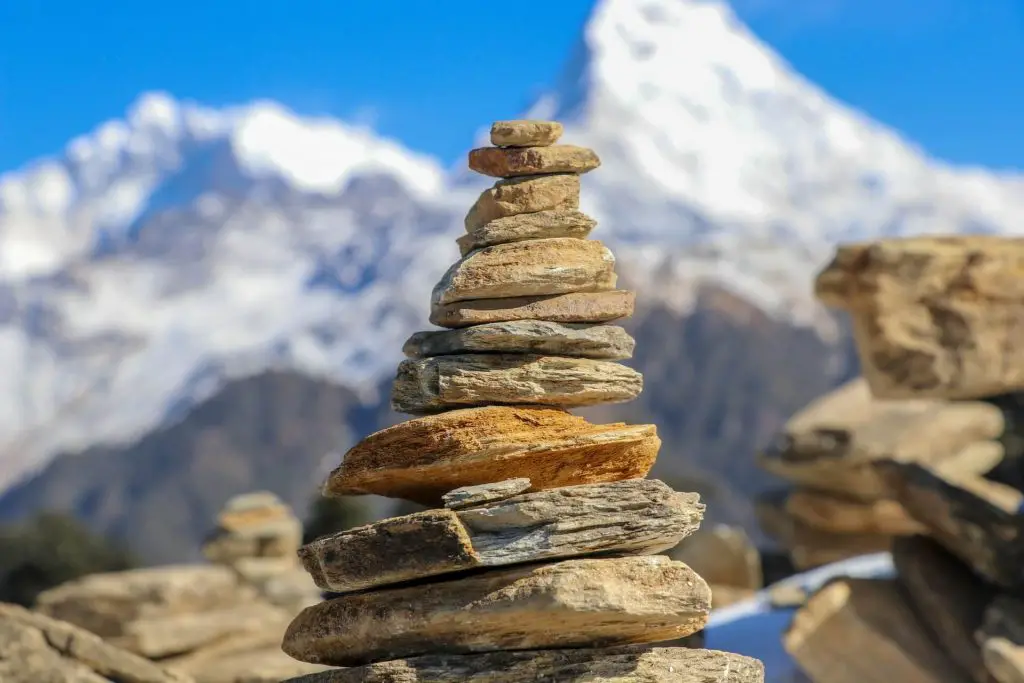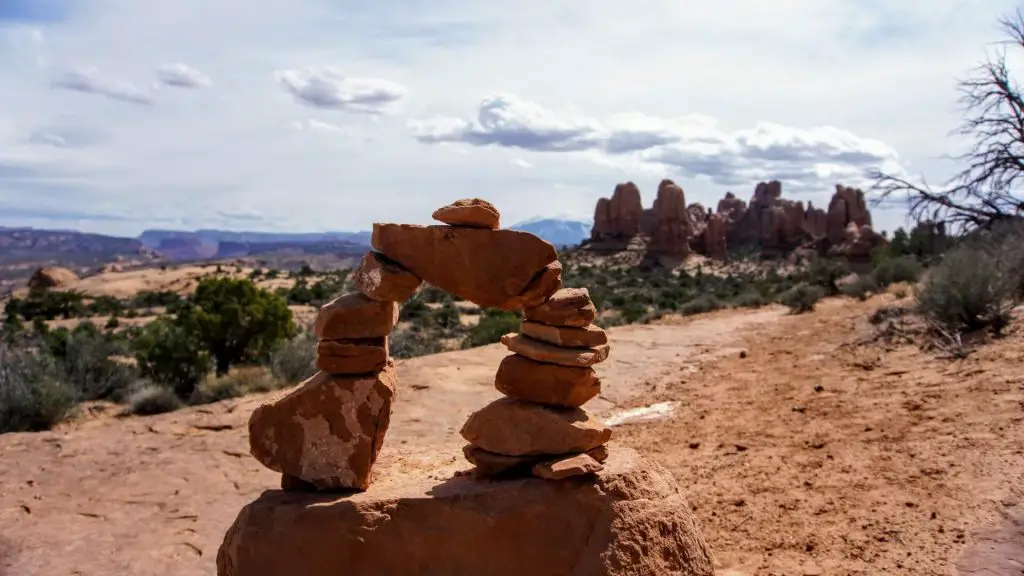
As you’re walking along the dirt path of your hiking trail, you might have encountered purposefully stacked rocks and wondered, why do hikers stack rocks? I have hiked hundreds of miles and have seen these rock stacks from deserts to the red rock canyons in Utah, along the coast of California, and even to the highest peaks in the Sierras.
There may be a time when you’re on the trail and there is no obvious path forward, so some hikers stack rocks to help others navigate the trail safely on ambiguous parts of the hiking trail.
Although one of the reasons hikers stack rocks is to help others find their way, these stacks of rocks are a source of controversy for hiking communities and have created many polarizing viewpoints. Some view these stacked rocks as disruptive to the environment and unnatural, while others view them as helpful guides, so which is it, are these stacks of rocks helpful or harmful?
What these stacks of rocks are for
These stacks of rocks, better known as cairns, have been around for thousands of years. In olden times cairns have been used for marking rails, ceremonies, marking buried items, hunting, and even for astronomy. Today you will mostly find cairns on hiking trails and other natural locations around the world.

Navigation
The main purpose of cairns on hiking trails is to assist hikers with following the correct path. If you have ever been on a section of the trail and wondered, where the heck do I go, then that is usually a good section to look around for cairns. I have been on sections deep in a canyon where everything looks exactly the same and luckily I was able to spot some cairns and found the path forward. In certain National and State parks there are authorized cairns that are officially designed and built by park rangers to help hikers navigate popular hiking trails.
Plan Ahead
Although cairns can help you navigate during ambiguous parts of the trails, you should not rely on them for navigation. Be sure to scout out your trail before, make note of any ambiguous portions of the trail, and be mindful when you are out on the trail. Sometimes there won’t be cairns to rely on and properly guide you, so have a topographic map or outdoor rated GPS device to help you with your navigation so you can safely hike your path.
Alerting Danger
Another helpful purpose of strategically placed cairns is to warn hikers about dangerous parts of the hiking trail. Examples of this could be a sudden drop off of a cliff or unstable ground. I have seen cairns in front of brush which was placed to warn me of a steep canyon drop-off. So if you see cairns in obscure areas, then they are likely warning you about an impending danger spot.
What these stacks of rocks aren’t for
While cairns are incredibly helpful when you are not sure of the next step you should take on your hike, there are other times where you will see cairns in the wild. Sometimes they will even be right next to a trail marker sign which is totally unnecessary.
Photography and Social Media
With the rise of social media, some hikers will opt to create cairns in order to snap a photo and leave the cairn there. This is not the purpose of cairns and does not help other hikers. While taking great photos of the outdoors is a lot of fun, creating cairns just for photos should not be done as they could cause confusion for hikers that use them to navigate.
Why should you not stack rocks?
Despite rock stacking being fun or even meditative for some, there are a few reasons you should not stack rocks. In my earlier years of hiking, I didn’t pay too much attention to cairns as they seemed completely innocent and harmless to the environment. I usually thought it was just kids having fun, but after some digging, there are unintended consequences for all of these cairns appearing.

Wildlife
Certain hiking trails where many cairns have appeared have a direct impact on wildlife. Moving so many rocks impacts bugs and other small animals by disrupting their environment. These bugs and small animals rely on the rocks for their homes, protection from predators, nests, and many other uses. Hikers may think they are only grabbing just a few handfuls of rocks, but multiply that by thousands of hikers over the course of many years and the impact is harmful to the wildlife. These rocks that are displaced take away potential homes and protection from wildlife which then forces them to migrate to other locations.
Environment
The next way that cairns are harmful is that they directly impact the environment. Some hikers will take hikers from various parts of the trails and scatter them as cairns. This can disrupt the environmental ecosystem of the local land by causing erosion. The impact isn’t seen by just one or two rocks stacked, but the tens of thousands that are stacked and compounded over time. Cairns are not a natural part of the environment, so if you already see a few helpful cairns, just remind yourself that there doesn’t need to be another one added as it will impact the wildlife and local environment.
Leave No Trace
One of the seven principles of leave no trace is to leave what you find. Any leaves, rocks, plants, wildlife should be left as they are during your hike. When visiting your hiking trails treat them with respect and leave no trace as to not impact the environment. Stacking rocks directly violates this principle.
What should you do when you see stacked rocks on the trail?
Some cairns are designed to help hikers find their way while others were built out of play and innocence, so what should you do when you see these stacked rocks on the trail? Your first instinct may be to kick them down or try to return the rocks to their original places, however, the damage could be made worst by these actions. There could be unintended consequences of knocking down the cairns.
Alert Park Rangers
If you see a significant amount of rock cairns that are not placed to assist with guidance and are disturbing the flow of the trail then alert the local park rangers to notify them of these rocks. Park rangers will be trained on how to properly disassemble the cairns and return the rocks to their proper locations with minimal impact to the environment.
Do not add to them
While it may be tempting to add to large cairns, you should refrain from doing so. You could potentially damage the cairn and cause it to collapse which would cause confusion for future hikers. These larger cairns are likely officially authorized cairns created by park rangers in order to help the mass of hikers stay on the right hiking trail.
Summary

Seeing these rock stacks on the trail is a cool sight to see at first, but when you learn the history and the purpose behind them, then you realize how helpful or harmful they can be when you’re out on the trails. Cairns that are placed on ambiguous parts of the hiking trail is a welcome sight for lost or wandering hikers, but with too many, it can have a negative impact on the environment. The original intent of cairns on hiking trails was to help hikers find their way but now has grown into a polarizing fight on why or they shouldn’t exist on the trails.
If you follow leave no trace and just observe, but not touch the rocks, then you will be doing your part to help maintain the great outdoors. Just leave it to the park rangers to setup official cairns, and be mindful the next time you get an itch to build a stack of rocks, that you could be picking up a bug’s home or be eroding part of the ground away years down the line.
